
The Mossy Creek & Greasy Rock Railroad is an 8' p;x 20' "O" scale (1:48) model train layout built on a base made of three sheets of 4' x 8' plywood. The layout is a simple dog-bone with a passing siding on each end which allows three trains on the layout at a time. The layout is fully landscaped and detailed with buildings, cars, and people. Trains run from the small town of Mossy Creek to the rural community of Greasy Rock.
I will answer that question in reverse order -- with "Why Greasy Rock" first. My family's ancestors for six generations back hail from Sneedville, a small, rural farming community in Upper East Tennessee. The original name for Sneedville was Greasy Rock. It was named after a large, flat rock on the Clinch River where early pioneers butchered and dressed animals after a hunt, leaving the rock greasy. Sneedville is surrounded by steep mountains, and is inaccessible by rail. Nevertheless, I named my railroad after that landmark, even though a train never ran anywhere near there. As for Mossy Creek, the town where I currently live used to be known as Mossy Creek.
The MC&GR Railroad is modeled in "O" scale (the letter "O" - not zero). "O" scale is popularly synonymous with Lionel, even though Marx offered fierce competition. "O" scale trains are still manufactured by Weaver, Williams, Mike's Train House (MTH), Atlas, and others. "O" is one of the larger model train sizes. It is smaller than G (garden scale), but is larger than "S", "HO", "TT", and "N" scale. For comparison, "O" scale engines and rail cars are typically 8 - 12 inches long. A small house in O scale might be 6" x 6" and about 4 inches high. O scale models are twice the size of "HO" scale, which is the most popular scale in the United States. By the way, the term "HO" stands for "Half-O" because HO scale, at 1:87, is half the size of European O scale which is 1:43. (American O scale is 1:48).

Size Comparison of different scales
Scale represents the ratio of the model to the prototype or life-size object. American "O" scale can also be expressed as "1:48" and "¼" scale.
The expression "1:48 scale" means one scale inch is equal to 48 real inches. Thus, a 1-inch long object on my model railroad would be 48 inches long in real life.
The designation "¼" scale" (or ¼ scale") comes from the ratio of 1 scale foot is equal to 4 real feet (48"). Again, a 1-inch long object on my model railroad would be 4 feet long in real life. To make matters more complicated, "O Scale" is not strictly defined as 1:48, but a range of scales with sizes from 1:42 to 1:48 are accepted as "O Scale". Some model railroaders do not stick to strict scale at all. Some will use the highly popular Hot Wheels ® or Matchbox ® brands of automobiles with their trains, even though the vehicles are 1:62 scale. Lionel ® itself has loaded the undersized cars on its products. Click here for more on the different Gauges and Scales and What they mean (courtesy of Model Train Stuff).
My layout is 8' x 20'. I built it with three sheets of 4' x 8' plywood set in a figure "L". I ripped the middle 4' x 8' sheet down to 3' x 8' to make it easier to reach the back of the layout. The layout is housed in a 12' x 20' shed called, "The Doghouse". Whenever I want to get away from my wife (or she wants me to get away from her), I go to the " Doghouse".
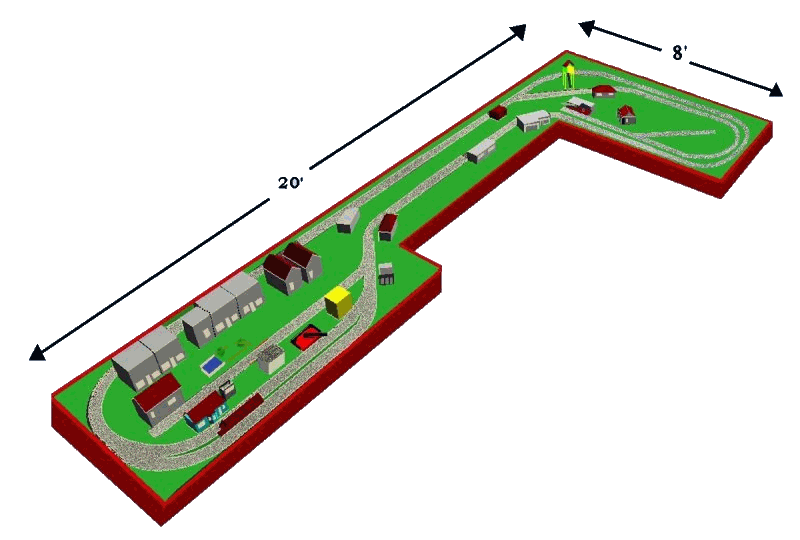
The track plan is an elongated oval or dog-bone with a passing siding on each end. I can run three trains at a time, well... sort of. I can have one train running on the main line while two others wait in the station sidings. If I'm careful, I can pull one train out from the station as the other pulls in. I thought about using relays to automate the arrival and departures, but I'm keeping it low-tech for now.
A single road runs the length of my layout with a combination of building kits, and scratch-built structures on either side.
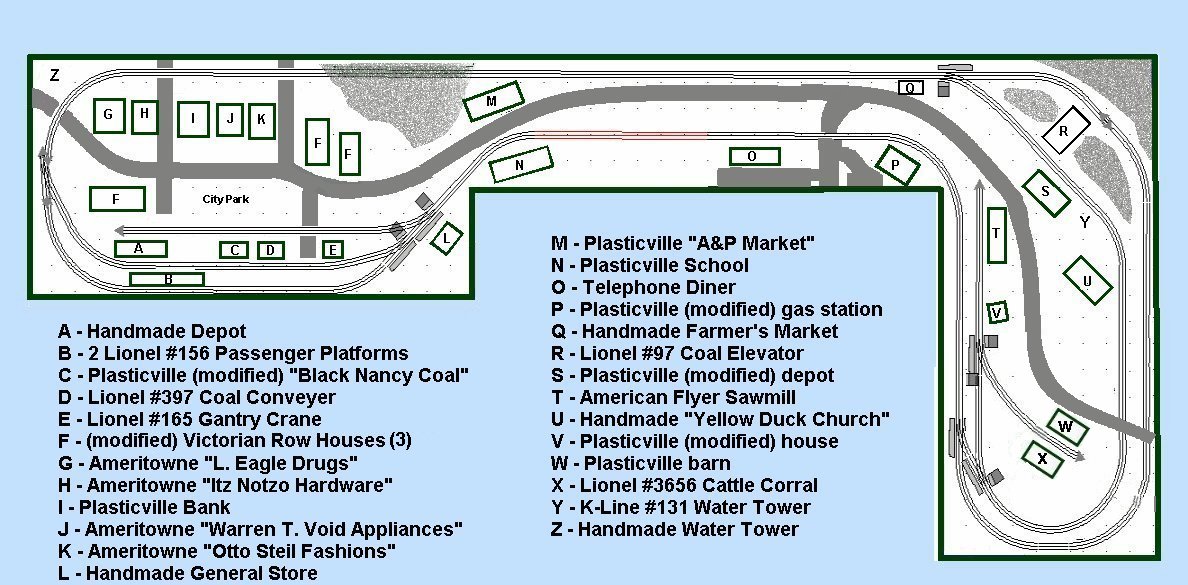
They say once you own two of anything, you're a collector.I got my very first Lionel train over forty years ago. But I didn't really start collecting trains until about twenty years ago, when I bought my first add-on piece for my original train set in February of 2002. I didn't get serious (obsessed) about buying and collecting until 2004. Since then,I have acquired quite a few pieces.
You can see some of the engines I have collected in this short video:
The Long Answer:
Most of my trains are from what collectors call the Post-War Era. Lionel manufacturing is divided into four Eras: Pre-War, Post-War, the MPC Era, and the Modern Era. Trains from the Pre-War Era were built before the Second World War, between 1914 and 1943. Pre-War trains were made of stamped steel sheets with lithographed (printed) details.
The Post-War Era began in 1947 (after World War II). Post-War trains were made of cast metal and the cars were made of injection-molded plastics, two processes perfected during the war. The 1950's were Lionel's "Golden Years" of Post-War production; the most popular and most durable of Lionel trains were produced during the late 1950's Golden Years. The Post-War era lasted until the end of the decade.
The 1960's brought a sharp decline in demand as slot cars and rocketry became popular. Lionel fought back by building train-and-race car combinations and space-themed train sets, but sales continued to drop. By the late 1960s, Lionel had leased their tooling and the Lionel brand name to General Mills, who would make Lionel trains under license in 1970. General Mills assigned the Lionel division to its subsidiary, Model Products Corporation [MPC], and the MPC Era was born. Lionel’s production managers quickly eliminated details like bells, whistles, and complex driving rods. They replaced cast metal train bodies with inexpensive lightweight plastic and redesigned parts to have less detail and lower cost of production. At one point, they replaced the venerable AC motors with DC "can" motors from the growing RC racing hobby. It was hard times for Lionel trains.
The Modern Era saw a re-birth of Lionel as children of the 1940's moved into retirement age. With some discretionary income to spend and a desire to re-acquire the quality toys of their childhood, sales of Lionel products, both new and used, increased. The Modern era is defined by a return to cast metal engine bodies, greater detail in castings, and the addition of modern electronic components and sound.
As I said earlier, most of my pieces are Post-War production. Pre-War trains are interesting, but for the most part, look more like toys than models. Some (the electric cabs) do not even resemble trains. The MPC Era stuff was cheaply made and molded in gaudy colors. The Modern Era stuff is expensive and technologically complex. The Post-War stuff is plentiful, affordable, durable, and easily repaired, How many other toys are still working after forty years?
The Short Answer:
Most of my trains are from the Post-War Era. My newest engine was built in 1998, and the oldest engine is almost a hundred years old. However, the majority of the trains I own are from the late 1950's - the "Golden Years" of the Post-War production era (1945-1963).
A whole lot of time and way too much money.

My interest in toy trains began when my dad purchased a Lionel Silver Star train set in 1974 from a closing Howard Bros. Department Store. I was 11 years old. I don't remember ever receiving or opening the box, it was just always "there." My brother and I would remove the twenty or so pieces of 3-rail metal track that formed a figure 8 and connect them together. Then, we would carefully take the engine and cars from their protective styrofoam box and place them gently on the track. After connecting the power to the track, we were ready to play. For the next hour, untold numbers of stalled Hot Wheels cars and slow-moving plastic green Army men were sent in an airborne trajectory by the speeding locomotive and its trailing consist of brightly colored freight cars. Then one day, like all boys do, I decided to take the engine apart to see how it worked. After that, she didn't run any more.
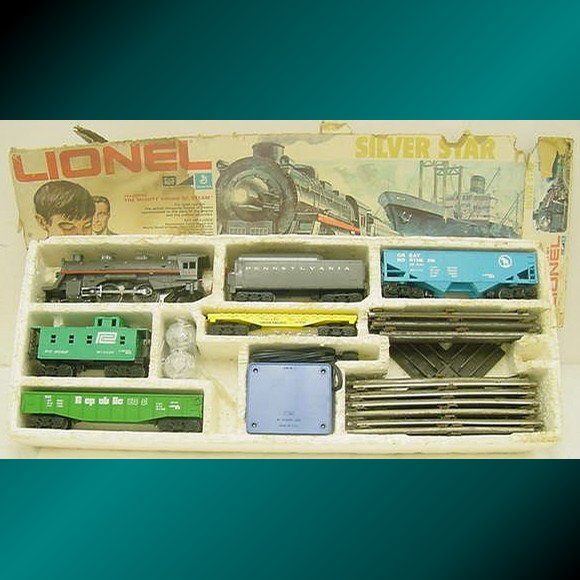
The Silver Star train set - 1975
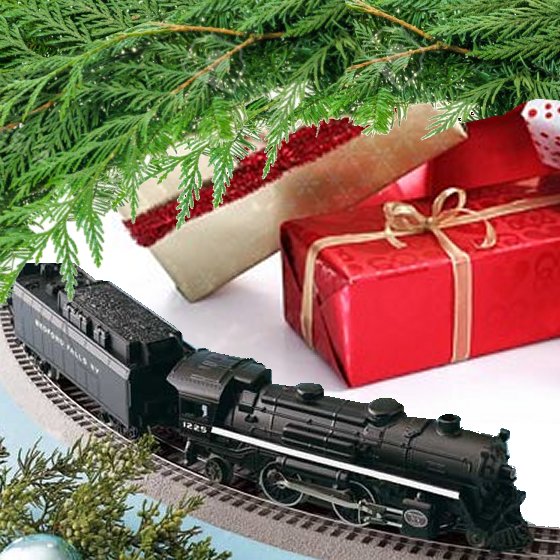
A Lionel train under the tree
By the year 2002, I was through college, married, and in the military. I had hauled that Silver Star train set from duty station to duty station, without ever opening it. But this year, as Christmas approached, I got the wild idea to set up the train around the base of the tree. After all my childhood abuse, I didn't even know if it still worked. I took the pieces out of the box, put all the loose parts back on the engine, set in on the track... and it ran! It was so cool to have this classic toy running around under our Christmas tree.
The "Silver Star" set I owned came with a hopper, gondola, flat car and caboose. I was kind of annoyed that the set didn't have a box car. After all, the boxcar is the most common freight car on any railroad.  I had learned about eBay in 2002 and decided to buy a box car. It became addictive and I began buying cheap pieces as I would come across them. My first purchase was a 3464 New York Central Operating Boxcar for $6 plus postage. That was followed by an amateur restoration of a 1688e streamlined engine and tender, a couple of Plasticville houses and a MRC Tech II transformer. After that, my life became like the Weird Al song parody, "What I Bought On eBay:"*
I had learned about eBay in 2002 and decided to buy a box car. It became addictive and I began buying cheap pieces as I would come across them. My first purchase was a 3464 New York Central Operating Boxcar for $6 plus postage. That was followed by an amateur restoration of a 1688e streamlined engine and tender, a couple of Plasticville houses and a MRC Tech II transformer. After that, my life became like the Weird Al song parody, "What I Bought On eBay:"*
"My house
is filled with this crap --
shows up in bubble-wrap,
most every day: what I bought on eBay."
* Audio excerpt is from the song, 'eBay' on the 'Weird Al' Yankovich album
'Poodle Hat', released 2003. Used under Creative Commons License
The following year, I saw a lot of new (to me) items delivered. I did not buy anything expensive (although in retrospect, the shipping costs made them expensive). And I only purchased something if I was interested in keeping it - no resale items. My collection includes one of my strangest pieces, the "Audio-Engineer" by Electro-Nuclear Development.

Attic layout
Christmas was the only time I got to set up my train and play with it. But Christmas only comes once a year, and I wanted my trains to be available and on display longer than one week a year. The only open space available year-around in our house was a storage space above the garage in the attic. So I built a shelf between the rafters and screwed down an oval of track. The attic was uninsulated, and the temperature was uncontrolled. It would average 40° in the Winter, and be above 100° in the Summer. Because of the extreme temperatures, my Christmas-only railroading season was extended just a week or two in late Summer and a week or two in early Fall.

My first "permanent" layout
In 2005, we moved to a sprawling 3-story house with a full-size finished basement. I built three wood tables, two with 4' x 8' plywood tops, and one with a 3' x 8' top. (The 3' top was necessary because I can't reach across four feet). I set the tables up in the corner in an 'L' configuration that gave me 8' x 12' of track area. I purchased a case of Gargraves Phantom center-rail flex track and glued and screwed it to Woodland Scenics foam railbed. Then I began the process of adding structures and scenery. The basement became my railroad's home for the next three years.

The "Doghouse"
When I retired from the military in 2008, I packed up the three train tables and moved them to our current home. I worked as a independent contractor for a while, and my wife encouraged me to build a home office in the back yard to conduct my business. I had a 12' x 20' stand-alone work shed built on-site for my office. My father-in-law helped me insulate and drywall the interior. It installed carpet, electricity, internet, telephone, a space heater and air conditioning. Initially, I used half of the space for my home office and reserved half the space for the railroad. Two years later, I quit my self-employment and turned the entire shed into my train emporium. My wife calls it "the Doghouse." With both of us at home together, if I get on her nerves, she can put me in the doghouse, and that's O.K. with me.

A visitor to the "Doghouse"
Between 2010 and 2012, I had brought the railroad to a near-finished state (model train layouts are never really completed). Once all the track and scenery was laid down, I began going back and replacing store-bought structures with hand-made or modified structures. The Plasticville chapel was replaced by Yellow Creek Baptist Church, a church-house completely hand-made. Only the steeple remains of the original. The.roadside farmer's market, and the Mossy Creek staion were also made from scratch,The under-sized Plasticville barn was raised with a stone foundation made of styrofoam, and I added a hay-covered loft floor. I also added a lot of detail items and "mini-scenes",such as the blonde chick in the convertible stopped by the Highway Patrol, the eight road workers fixing one pothole, and the man standing in his underwear in the clothing store. I have had many visitors, and I don't know who enjoys it more: the children or their parents.

A visitor to the "Doghouse"
Between 2008 and 2012, I c. Once all the scenery was completed, I began replacing purchased structures with hand-made or modified. The Yellow Creek Baptist Church is completely hand-made, as is the roadside farmer's market, and more recently the main depot. I also added a lot of detail items and "mini-scenes",such as the blonde chick in the convertible stopped by the Highway Patrol, the eight road workers fixing one pothole, and the man standing in his underwear in the clothing store. I have had many visitors, and I don't know who enjoys it more: the children or their parents.
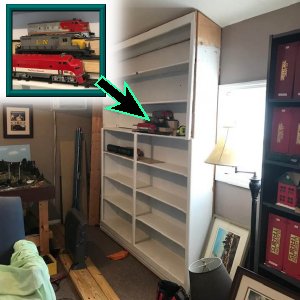
New construction
In 2016, something got cross-wired on my layout and I burned up several lights and switch machines. I also began having serious health issues. An aneurysm necessitated brain surgery which left me partially disabled. As a result, I lost both the ability and interest to update the layout, However, in 2019, I attended the 3d Annual "Big Train Show" hosted by the George. L. Carter Railroad Museum in Johnson City, Tennessee, and that rekindled my interest. I added a large display shelf to "the Doghouse" and began repairing the electricals. I am one step closer to a dream of a small toy train museum.
Mossy Creek was a supply point for early explorers into the Appalachian Mountains in the late 17oo's. One of the first settlers in the area was the family of Lord Uriah Thomas Falls and his wife, Lady Patricia. When they arrived from Colonial Virginia in 1788, they found a small abandoned blockhouse beside a spring of fresh water flowing into a moss-bottomed creek. Tradition says that U.T. and Lady Falls set up their home in this structure by the mossy creek until they could construct their own log cabin and it was ready to be occupied.
There were a few subsistence farms scattered around that moss-covered creek, but the valleys were mostly covered with thick buffalo grass. The hills were rich with timber and so for the first forty or fifty years, lumbering was the principle non-farming occupation. Trees were cut down for local construction and to make way for farm crops, mainly corn and tobacco. Timothy Burr built a large sawmill near Mossy Creek about 1795, and shortly after, English woodworkers David Brogan and Michael Downe built a furniture factory, and the Mossy Creek Railroad made a weekly run between Tim Burr Lumber Mill and the Brogan-Downe Furniture Co.. Soon thereafter, Italian immigrant, Itz Notzo opened the first hardware store. The Itz Notzo Hardware Store was flanked by the business of a German tailor, Otto Steil's Clothing and the Gorabbah Bank. Warren T. Void opened an appliance store, and Lewis Eagle opened the first apothecary: L. Eagle Drugs.

Main Street Mossy Creek - c.1920
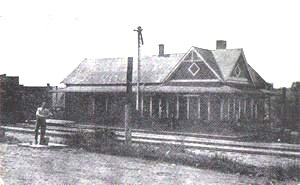
Mossy Creek Station - c.1925
By the middle 1840’s three factors helped increase the population of Mossy Creek: the Hitzal Mine began mining zinc in the 1830’s, the Yellow Duck Missionary Baptist Church began in 1851, and the East Tennessee Railroad between Bristol and Knoxville was completed in 1858. Still, by 1900, almost no one in East Tennessee owned a car, and the walk from surrounding townships to the Mossy Creek station could take as much as a day. The mountain people needed a convenient way to get to Mossy Creek to bring their produce to market and to shop for supplies.
The settlement of Greasy Rock began near a large, flat stone that protruded into a creek that ran into the Clinch River. The ledge was about four or five feet wide and extended from the creek about forty feet. The rock acquired its name from the pioneer hunters. A spring just below the present town was once a famous rendezvous for hunters and trappers, who would dress their skins and pile up venison and bear meat on a large rock there. This rock was, therefore, usually greasy, hence the name, Greasy Rock.
Jerry and Miah Greene, one of the earliest settlers of Greasy Rock community, obtained possession of a large parcel of land which was rich in coal and timber. Richard N. Aldatt built a prosperous coal mine in the mountainous countryside and needed a way to deliver the coal out of the mountains into the cities. Jerry built the Greasy Rock Railway with only a small steam-powered switcher engine, a few ore-dumping gondolas and some log-dumping flat cars. His rail line ran from Aldatt's Mine to the rural communities of Abijah Greene and William Bean in the valley. The rail line ended at the Greene-Bean Station, where the coal and logs were transferred to trucks for final delivery to households, businesses, and factories.

Mossy Creek Tram - 1928
In 1928, Henry Clay Lawson constructed the first passenger train service running between Mossy Creek and Greene-Bean Station. He ran a small red diesel-electric cab pulling two red coaches. With the completion of this line, the mountain people, coal miners, and lumberjacks could easily commute from Greene-Bean to Mossy Creek Station where they could make connections on the Knoxville-Bristol Railroad and destinations beyond.
Because the Greasy Rock RR was focused on lumber and coal, it eventually connected to the expansive Norfolk & Western Railroad and the coal giant, the Clinchfield Railroad. Cars from both of these lines can be seen on the Mossy Creek & Greasy Rock today. The Mossy Creek Railroad, meanwhile, developed a relationship with the Southern Railway, and to a slightly lesser extent, the Louisville & Nashville Railroads. In 1963, Bryan Lawson took over as CEO and consolidated the two lines. The Mossy Creek & Greasy Rock Railroad now has partnerships in the coal, zinc, lumber, cattle, tobacco, and furniture industries, and is a stopping point along the famous "Southern Crescent" passenger route.